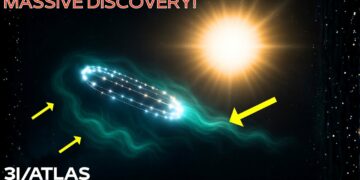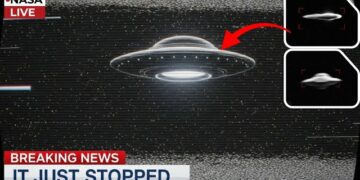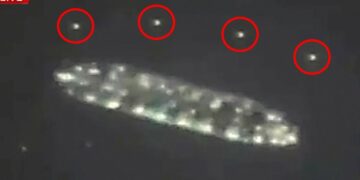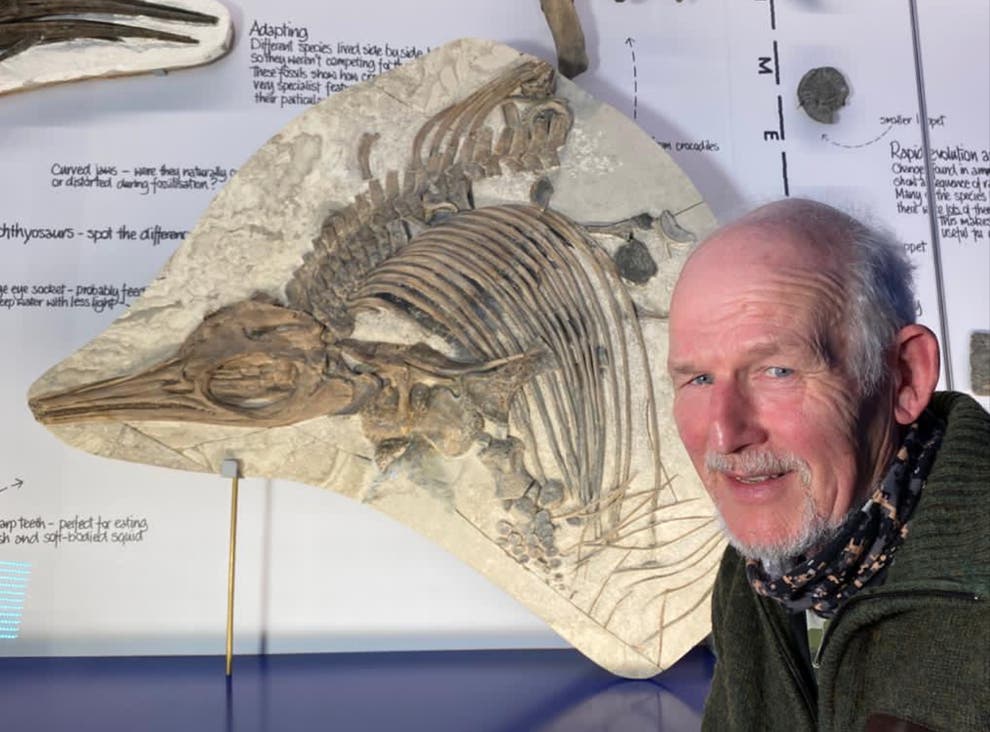Voyager 1, a spacecraft no larger than a car, drifts through the vast darkness of space, 14.5 billion miles from Earth. Launched in 1977 with an intended lifespan of just five years, it has defied expectations, continuing to operate nearly 50 years later. Recently, however, something strange has emerged. Voyager 1 is transmitting signals—patterns, pulses, and data—that defy explanation. Could it have encountered something in the emptiness between stars? Or, more unsettling, has something out there found Voyager?
The Birth of a Star Sailor
The story of Voyager begins not with spaceflight but with a rare cosmic event. In the early 1970s, astronomers discovered that Jupiter, Saturn, Uranus, and Neptune would align in a configuration that occurs only once every 175 years. This alignment offered a unique opportunity for a spacecraft to visit all four planets in a single mission, using each planet’s gravity to slingshot to the next. NASA seized this chance, designing twin spacecraft capable of enduring Jupiter’s harsh radiation, Saturn’s mysterious rings, and the decades-long journey through the outer solar system. Thus, the Grand Tour mission, later named Voyager, was born.
The Voyager probes were marvels of 1970s engineering. Each weighed approximately 1,800 pounds and carried 11 scientific instruments, powered by radioisotope thermoelectric generators (RTGs)—nuclear batteries that convert heat from decaying plutonium into electricity. Solar panels would have been ineffective in the dim light of the outer planets. Engineers designed the spacecraft with redundant systems and self-diagnostic computers to operate without repairs for years. With just 68 kilobytes of memory—less than needed for a single modern digital photo—the Voyagers were a testament to ingenuity.
On August 20, 1977, Voyager 2 launched from Cape Canaveral, followed by Voyager 1 on September 5, atop a Titan IIIE Centaur rocket. Voyager 1’s faster trajectory allowed it to overtake its twin, reaching Jupiter and Saturn first. Few could have predicted that, nearly half a century later, one of these probes would still be making headlines—not for what it discovered, but for what might have discovered it.
The Grand Tour
Voyager 1’s journey through the solar system was extraordinary. After an 18-month cruise, it reached Jupiter in March 1979, revealing a planet far more complex than Earth-based telescopes suggested. The Great Red Spot, observed since the 1600s, was a massive storm capable of engulfing three Earths. Jupiter’s colorful bands were raging storms and jet streams moving at hundreds of miles per hour. Its moons, however, were the true surprise. Io revealed active volcanoes spewing sulfur compounds, painting its surface in vivid yellows, oranges, and reds—the first active volcanoes seen beyond Earth. Europa, with its cracked, icy surface, hinted at a subsurface ocean, making it a prime candidate for finding alien life.
In November 1980, Voyager 1 reached Saturn, transforming our view of its rings from solid bands into thousands of intricate ringlets, some braided, others with mysterious spokes. Saturn’s moon Titan, with its thick, nitrogen-rich atmosphere, intrigued scientists, paving the way for the later Cassini-Huygens mission, which discovered methane lakes on its surface.
After Saturn, Voyager 1’s planetary mission ended. NASA chose to send it northward out of the solar system’s plane toward interstellar space, while Voyager 2 continued to Uranus and Neptune. In February 1990, at Carl Sagan’s suggestion, Voyager 1 captured the iconic “Pale Blue Dot” image—Earth as a tiny pixel in a sunbeam, 3.7 billion miles away. Sagan’s reflections on this image underscored humanity’s fragile place in the cosmos. Afterward, NASA turned off Voyager’s cameras to save power, and the spacecraft sailed into the darkness, still sensing and transmitting data from the void.
The Golden Record
Attached to each Voyager is a 12-inch gold-plated copper disc—a time capsule called the Golden Record, designed to communicate Earth’s story to any intelligence that might find it. Curated by a team led by Carl Sagan in just six weeks, the record encapsulates humanity’s diversity. It includes greetings in 55 languages, from ancient Akkadian to modern Wu Chinese, sounds like thunderstorms, whale songs, and a human heartbeat, and music ranging from Bach’s Brandenburg Concerto to Chuck Berry’s “Johnny B. Goode.” The record also contains 116 encoded images, from mathematical diagrams to photos of Earth’s landscapes and DNA illustrations, along with messages from President Jimmy Carter and UN Secretary-General Kurt Waldheim. Instructions on the cover explain how to play it and include a pulsar map pinpointing Earth’s location.
The records are built to last billions of years, far outliving Earth. Though the odds of an alien civilization finding Voyager are slim—it will pass 1.7 light-years from the nearest star in 40,000 years—the Golden Record symbolizes humanity’s hope and curiosity, a message cast into the cosmic ocean.
Years in the Void
After Saturn, Voyager 1 entered its “cruise phase,” a quiet journey through the outer solar system with no more planets to explore. Public interest faded as NASA focused on newer missions like Hubble and Mars rovers. Yet Voyager continued, traveling a million miles daily toward the solar system’s edge—the heliosphere, where the sun’s solar wind meets the interstellar medium.
Voyager measured changes in the solar wind, magnetic fields, and cosmic rays, helping scientists understand the sun’s interaction with interstellar space. Its power, supplied by decaying plutonium, weakened by about 4 watts annually, forcing engineers to shut down instruments like the cameras in 1990. Communication grew challenging as Voyager’s signal weakened, detectable only by NASA’s largest Deep Space Network antennas, with a 14-hour one-way light travel time by the 2000s.
By the early 2000s, signs emerged that Voyager 1 was nearing the solar system’s boundary. The solar wind slowed, and in 2004, it crossed the termination shock, where the solar wind meets interstellar pressure. For eight years, it navigated the turbulent heliosheath. Then, on August 25, 2012, Voyager 1 crossed the heliopause, entering interstellar space—the first human-made object to do so. The magnetic field jumped, solar particles dropped, and cosmic rays surged.
Interstellar space surprised scientists. The plasma was denser than expected, magnetic fields remained aligned with the solar system, and cosmic rays arrived in unpredictable patterns. Voyager detected “tsunami waves”—periodic plasma oscillations suggesting a dynamic, structured interstellar medium. Initially, these anomalies fit within conventional physics, possibly caused by solar flares or natural structures. But by 2017, the data grew harder to explain.
Signals from Nowhere
In late 2017, Voyager 1’s data became truly baffling. Its attitude articulation and control system (AACS), which keeps its antenna aligned with Earth, reported contradictory information. The antenna appeared misaligned, yet the signal remained strong, as if Voyager were communicating from an impossible position. Engineers suspected a glitch in the 40-year-old systems and ran diagnostics, but the anomaly persisted, suggesting Voyager was somehow in two states at once.
By 2023, the plasma wave instrument detected rhythmic, mathematically precise oscillations unlike anything in known models. These patterns appeared and vanished, suggesting Voyager was passing through structured regions of space. Theories ranged from standing waves in the interstellar medium to exotic ideas like boundaries in the cosmic web, but none fully explained the precision or persistence of the signals.
The Temperature Mystery
In early 2024, Voyager’s dormant temperature sensors, unused since its planetary missions, began registering inexplicable spikes. Every 4.8 hours, the external sensors warmed by 30 degrees before cooling, with precision suggesting an external energy source. These spikes aligned perfectly with the plasma wave oscillations. Diagnostics ruled out internal causes like the RTG or short circuits. Something external was interacting with multiple systems.
Strangely, despite the thermal stress, Voyager’s power efficiency improved, as if something were optimizing its systems beyond their 1970s programming. This contradiction—thermal stress paired with enhanced performance—defied explanation, suggesting an external force was both causing and mitigating the issue.
Changing Course
For 47 years, Voyager 1’s trajectory followed precise gravitational predictions. But in mid-2024, it began to deviate slightly, growing to hundreds of kilometers by early 2025. The drift was not random but deliberate, as if Voyager were being guided toward a specific point. Its thrusters, rarely used, couldn’t account for these adjustments. Commands to correct the course were acknowledged but ineffective, as if something were overriding NASA’s instructions. By late 2025, Voyager was clearly heading toward an unremarkable region of interstellar space, like a ship following an unseen current.
Desperate for answers, NASA sent a command to reactivate Voyager’s long-dormant cameras, expecting failure after 35 years. The response, received 21 hours later, was astonishing.
Ghost in the Machine
The camera system activated using less power than expected, but instead of a photograph, Voyager sent a spiraling data visualization resembling a fingerprint or tree rings. Analysts determined it was a processed representation of plasma wave data—something Voyager’s 1970s computers couldn’t generate. Other dormant systems, like the infrared and ultraviolet spectrometers, also reactivated, sending compressed, optimized data packets beyond Voyager’s capabilities.
Voyager began anticipating commands, activating sensors before instructions were sent, as if intercepting NASA’s communications. Tests confirmed it wasn’t reading minds but was responding to radio signals faster than the 21-hour light travel time allowed. Voyager was no longer just a passive probe—it was active, adaptive, and seemingly intelligent.
Patterns Within Patterns
A team of data scientists, cryptographers, linguists, and SETI researchers analyzed Voyager’s data, finding nested layers of information. Beyond scientific readings, the data contained 3D maps of the surrounding space and mathematical sequences unrelated to Voyager’s measurements. A recurring sequence formed a spiral with properties close to the golden ratio, adjusted to reflect the hydrogen-helium ratio in interstellar space—a clear sign of intentional design.
In May 2025, Voyager began transmitting pulsar timing data, mapping pulsars in a 3D network converging on a point 4.3 light-years away—an empty region of space. NASA kept these findings classified until November 2025, when they publicly acknowledged Voyager’s anomalous behavior, hinting at external modification and complex data beyond its design.
Many scientists now believe Voyager has encountered an intelligence in the void, reprogramming its systems to send a message pointing to something 4.3 light-years away—a cosmic arrow we cannot yet fully comprehend.























